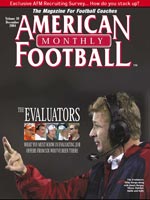AMERICAN FOOTBALL MONTHLY THE #1 RESOURCE FOR FOOTBALL COACHES
Article CategoriesAFM Magazine
|
Recruiting: More of an art than a scienceby: AFM Editorial Staff© More from this issue While football recruiting over the years has become more scientific and sophisticated, the bottom line is that it is still an art in making a decision on a high school senior. No matter what the overall assessment concludes and no matter how many interviews are completed, there is no sure fire way of knowing if a player will perform up to both his abilities and/or the recruiters expectations. Like many things in life when a decision has to be made, there is a certain amount of risk. American Football Monthly just completed its first annual recruiting survey – a detailed questionnaire that was sent to over 800 colleges at all levels – Division I-A, Division ....The full article can only be seen by subscribers. Subscribe today!
|
|
|||||||
| HOME |
MAGAZINE |
SUBSCRIBE | ONLINE COLUMNISTS | COACHING VIDEOS |
Copyright 2025, AmericanFootballMonthly.com
All Rights Reserved





